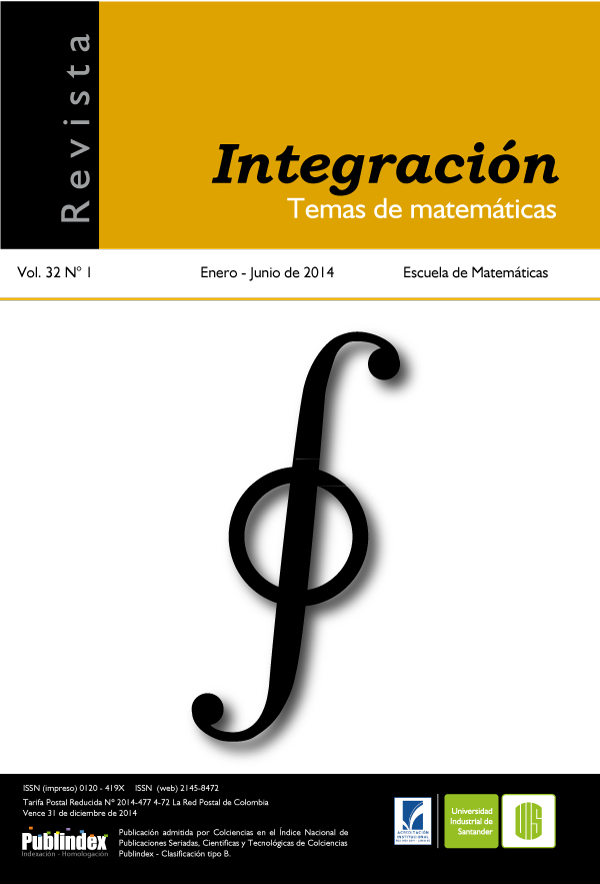Publicado 2014-05-22
Palabras clave
- Lógica lineal,
- categorías monoidales,
- categorías enriquecidas,
- semántica categórica
Cómo citar
Resumen
La semántica categórica ha permitido establecer de forma precisa y formal el significado de los términos y conectivos de distintas lógicas. En particular, los trabajos de distintos autores empezando por de Paiva y Hyland [3] han permitido abordar desde el enfoque categórico la semántica de la lógica lineal, tanto clásica como intuicionista. Uno de los aspectos más relevantes consiste en intentar dar una interpretación categórica al operador exponencial !. Mellies [11] y Bierman [4] finalmente han mostrado que esta interpretación corresponde a un composición entre adjuntos monoidales. Con la aparición de SELL, ahora se cuenta con una familia de subexponenciales ajustados dentro de una estructura de preorden. Lo que se pretende en este trabajo es obtener una interpretación categórica para esta familia de subexponenciales, inspirados en la misma noción de adjuntos monoidales, pero que respete la estructura de preorden asignada para la familia de exponenciales.
Para citar este artículo: C. E. Ramírez, Semántica categórica para subexponenciales en SELL, Rev. Integr. Temas Mat. 32 (2014), no. 1, 39–54.
Descargas
Referencias
- Andreoli J.-M., “Logic Programming with Focusing Proofs in Linear Logic”, J. of Logic and Computation 2 (1992), no. 3, 297–347.
- Benton P.N., A mixed linear and non-linear logic: proofs, terms and models, Proceedings of Computer Scienca Logic 94, Springer Verlag, LNCS 933, 1994.
- Benton P.N., Bierman G.M., de Paiva V.C.V., Hyland J.M.E., Term assignment for intuitionist linear logic, Technical Report 262, Computer Laboratory, University of Cambridge,
- Bierman G., On intuitionist linear logic, Thesis (Ph.D.), University of Cambridge, 1994.
- Danos V., Joinet J.-B. and Schellinx H., The Structure of Exponentials: Uncovering the Dynamics of Linear Logic Proofs, In Georg Gottlob, Alexander Leitsch and Daniele Mundici,
- editeurs, Kurt Gödel Colloquium, 713 of LNCS, p. 159-171. Springer, 1993.
- Girard J.-Y., “Linear logic”, Theoretical Computer Science 50 (1987), 1–102.
- Kelly M., Basic concepts of enriched category theory, volume 64 of LMS, Lecture Notes. Cambridge University Press, 1982.
- Kelly M., “Doctrinal adjuntion”, Lecture Notes in Math. 420 (1974), 257–280.
- Lafont Y., Logiques, catégories et machines, Ph.D. Thesis, Université Paris 7, 1988.
- Mac Lane S., Categories for the Working Mathematician, Springer Verlag, 1971.
- Melliès P.-A., Categorical Semantics of Linear Logic, Panoramas et Synthèses 27, Société Mathématique de France, 2009.
- Melliès P.-A., Categorical semantics of linear logic, Interactive models of computation and program behaviour, Société Mathématique de France, 2009.
- Nigam V., Exploiting non-canonicity in the sequent calculus, Thesis (Ph.D.), Ecole Polytechnique, 2009.
- Nigam V. and Miller D., Algorithmic specifications in linear logic with subexponentials, In ACM SIG1015 PLAN Conference on Principles and Practice of Declarative Programming (PPDP), 129–140, 2009.
- Pimentel E., Nigam V. and Reis G., An Extended Framework for Specifying and Reasoning about Proof Systems, submitted to Logical Journal of the IGPL, (2012), p. 37.
- Seely R., Linear logic, *-autonomous categories and cofree coalgebras, Applications of categories in logic and computer science, Contemporary Mathematics 92, 1989.
